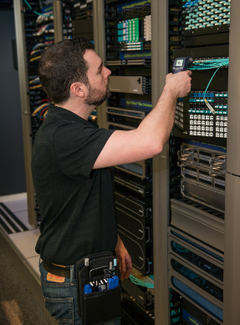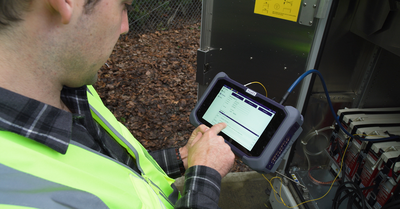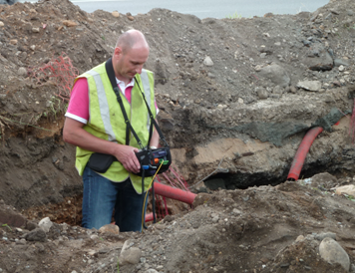What Kind of Tool Can Measure the Distance to the Location of Damage in a Cable?
What Is Fiber Testing?

Fiber testing encompasses the processes, tools, and standards used to test fiber optic components, cobweb links, and deployed fiber networks. This includes optical and mechanical testing of unimposing elements and comprehensive manual tests to verify the integrity of complete fiber network installations.
Fiber eyes have emerged as the world's leading communication transport medium. The increasing diversity of fiber optic applications has highlighted the need for technician grooming and versatile, user-friendly test solutions.
Since their inception in the 1970s, fiber optic networks have continually evolved and expanded. The emergence of 5G, submarine networks, and FTTx (Fiber to the X) have highlighted the importance of robust fiber testing and monitoring. VIAVI offers an unmatched heritage of technical proficiency, reliability, and collaboration for over 80 years that has yielded the industry's premier fiber testing solutions.
Cobweb Testing Standards
Cobweb optic industry standards have been developed over the years to certify fiber network components and installations prior to use. Equally deployments multiply, adherence to national and international standards is necessary to maintain consistency, interoperability, and performance.
Multiple standards bodies and working groups have been formed for each test category. As an active participant in standard development and review, VIAVI works side by side with the leading standards bodies to facilitate the next generation of fiber testing products and services.
Why Practice Cobweb Networks Demand to be Tested?
Manufacture standards and warranty requirements make testing fiber optic networks unavoidable, but there are many other reasons why fiber network functioning should be tested and monitored.
The market demand for bandwidth has led to an increment in the size and complexity of cobweb networks. Passive Optical Network (PON) architecture, DWDM (Dense Wavelength Division Multiplexed), and other innovations have introduced more cable segments and insertion loss locations, even as performance requirements increase and loss budgets decrease. Thorough and authentic fiber testing at all network levels and phases can ensure customer satisfaction and competitive edge.
Despite the all-time intentions of highly trained technicians, the effeminateness and scale of fiber optics can be unforgiving when information technology comes to contamination, micro-bending, and connector damage. Muddy connections remain the number one cause of fiber network failures. Testing the network comprehensively prior to turn-on allows any defects or impairment to be detected and repaired proactively.

The Fiber Testing Lifecycle
Fiber testing is frequently thought of every bit the installation activities that verify cobweb network readiness. In applied application, cobweb optic testing extends from the primeval evolution of new fiber optic components and systems in the lab to the monitoring and troubleshooting that ensure years of reliable cobweb performance in the field.

Aggrandize to enlarge
Fiber Optic Cable Testing Best Practices
Testing cobweb optic networks is an essential function of fiber optic installation, as well as ongoing maintenance. Post-obit some fundamental fiber testing all-time practices will lead to safer, more efficient, and more reliable fiber deployments and network activation.

- The importance of cleanliness in fiber installation and testing cannot be overstated. A fiber optic microscope tin can be used every bit a fiber optic tester to verify the cleanliness of the core and connecting ferrules. Automated inspection tools tin can be used for mutual cobweb interfaces like PON and MPO. Specialized cleaning materials are recommended for proper cleaning of fiber optic connections. This same attention to cleanliness should exist applied to reference cables and test equipment connections.
- When using a VFL (Visual Fault Locator) cobweb tester for fault location, middle safety is extremely important. Since a VFL utilizes a high-intensity light amplification by stimulated emission of radiation light source, neither the source nor the cobweb core illuminated by the VFL should exist viewed directly with the naked heart.
- The use of an optical light source and a power meter, or an optical loss exam set (OLTS), is considered a proficient fiber test practice for ensuring that the optical power upkeep is within design specifications. A calibrated optical light source (OLS) can be used in conjunction with an optical power meter (OPM) to quantify the insertion loss of the link prior to turn-up.
- An OTDR is the recommended cobweb optic test tool for detailed baselining and recording of fiber link 'characteristics'.
- The purpose of an OTDR is to detect, find, and measure events at any location on a fiber link. Location data regarding localized loss and reflective events is generated, providing technicians with a pictorial and permanent tape of the fiber'due south characteristics.
- When using an OTDR, apply launch cables to qualify the front-end and far-end connectors. A launch cable is connected between a tester and the fiber under test, and the receive cable is connected at the far end of the fiber link. It is of import to note that the fiber used in the launch and receive cablevision should match the fiber being tested (type, core size, etc.)
- Test process automation (TPA) principles that are effective on the production floor can besides be extended to fiber network installation. By minimizing manual exam processes and reducing opportunities for errors and grooming time, certification and plough-up tin be completed and documented confidently and predictably.
- Lastly, proper planning and preparation are bones all-time practices applicable to any organized endeavour, including fiber testing. Assembling and organizing a pre-cleaned, calibrated, and consummate exam tool kit is essential for carrying out the most effective and accurate fiber optic tests.
Fiber Testing and Fiber Optic Cable Construction
The application of fiber optic communication may seem elegant in its simplicity, but fiber optic cable testing requires an agreement of some bones principles that differentiate fiber testing from its analog wire testing predecessor.
An optical cobweb is composed of a very thin glass rod, which is surrounded by a plastic protective coating. Lite, which is injected into the cadre of the glass fiber, will follow the physical path of that fiber due to the total internal reflection of the light between the core and the cladding.

The Iii C's of an Optical Fiber
The basic elements of an optical fiber in terms of fiber testing are sometimes referred to every bit the "three C's":
- Core: The centre of the fiber cable, made of particularly treated glass or plastic. This is the medium for low-cal manual throughout the span of the cable, so it must exist as pure and make clean equally possible.
- Cladding:An additional layer made of material similar to the cadre, but with a lower refractive index to facilitate continuous reflection of the light source back into the core.
- Coating:The outer layer of the cablevision which wraps, protects, and insulates the core and cladding.
Types of Fiber
Fiber is classified into different types (multimode or single manner) based on the way in which the light travels through it. The fiber blazon is closely related to the diameter of the core and cladding. Multimode fiber has a larger core diameter that allows multiple modes of light to pass through it simultaneously.
The primary advantages of multimode fiber are the ease of coupling to light sources and to other fibers, lower toll light sources (transmitters), and simplified connectorization and splicing processes. However, its high attenuation (optic loss) and depression bandwidth limit the transmission of calorie-free over multimode fiber to brusque distances.
The reward of single-mode fiber is its higher performance with respect to bandwidth and attenuation.
The pocket-sized core size of single-manner fiber requires more expensive transmitters and alignment systems to attain efficient coupling. Notwithstanding, for high performance systems or for systems that are more a few kilometers in length, unmarried-way fiber remains the all-time pick.
Fiber Testing Methods and Types of Measurement
To appraise the quality of a fiber installation, sign it off as ready for service activation, and ensure reliable on-going operation of a cobweb link, some basic fiber test methods and tools should be used.
There are several important things to measure, assess and check:
Cobweb End-Face Inspection
When 2 fibers are mated together, a key requirement is to ensure light passes from fiber to fiber without excessive loss or dorsum reflections. What remains challenging is maintaining a pristine finish face. A unmarried particle mated into the cadre of a cobweb tin cause meaning insertion loss, dorsum reflection, and even equipment impairment. Proactive fiber inspection is essential to ensure reliable fiber connections.

Cobweb Continuity Examination
When you examination fiber optic cablevision networks, a visible laser source connected to ane end of the cable tin can be used to verify the transmission to the reverse end. This blazon of cobweb optic test is just intended to detect gross fiber defects such as macrobends. You tin also test fiber optic cablevision continuity to make up one's mind whether the correct fiber optic cable is continued to the right patch console location.
A fiber identifier (FI) is a useful handheld fiber examination tool that can place and find optical signals from the outside at any point forth the fiber link. Cobweb identifiers can be used to confirm the presence of traffic on a cobweb as well equally the management of the transmission.
A visual fault locator (VFL) uses visible spectrum laser light to test fiber continuity as well as detecting fault conditions. The red-light source will be visible through the coating at the location of any fiber breaks or defective splices. For fiber runs longer than 5km/3miles or where access to view the fiber is express, an OTDR tin be used as a fiber optic cable tester to pinpoint any continuity issues.
Optical Loss Measurement
Every bit the lite source traverses the fiber, it decreases in power level. The subtract in power level, also called optical loss, is expressed in Decibels (dB).
Some may ask what the 'right method for cobweb testing is'. The most accurate manner for fiber testers to measure the overall optical loss in a fiber is to inject a known level of light in 1 end and mensurate the level of light at the other end, using an OLTS. Since the optical light source and ability meter are connected to opposite ends of the link, admission to both ends of the fiber is required for this method.
Optical Power Measurement
A power measurement is a test of the signal strength from the transmitter once a arrangement is live or activated. An optical power meter volition display the optical power received on its photodiode and tin be continued directly to the optical transmitter's output or on a fiber cable at the indicate where the optical receiver would exist. Optical power tin exist measured in "dBm" units, where the "m" represents 1 milliwatt and the "dB" refers to decibels.
Testing Fiber for Optical Loss
When you test cobweb optic cables for optical loss, cobweb testers volition demand to connect to a test source to provide an optical calorie-free standard, as well as a launch cable to supply a calibrated "0 dB loss" reference. A ability meter at the contrary end of the circuit will measure out the low-cal source with and without the fiber under exam to quantify the loss in dB of the fiber itself.
Other methods for testing fiber optic cablevision connections include both launch cables and "receive" cables connected to the power meter. This is the standard test for loss in an installed cable constitute and includes the loss measurements at both test cable connection ends. For this reason, ensuring all connections are extremely clean is an important aspect of any fiber test.


An Optical Time Domain Reflectometer (OTDR) can as well exist used as a fiber optic cable tester to test optical loss. Utilizing high intensity light amplification by stimulated emission of radiation lite emitted at a pre-defined pulse interval through a connecting cable at one finish of the fiber optic cable run, the OTDR instrument analyzes the backscatter of light returning to the source location.
This one-ended fiber test method can be used equally a fiber optic tester to quantitatively analyze the loss, also as pinpointing the loss locations during installation, maintenance, and troubleshooting. Mini-OTDR products pack the functionality of a mainframe OTDR device into a handheld fiber examination product, and can integrate other capabilities like fiber end inspection, VFL, and power measurement. Learn more than about OTDR Testing.
The Origins of Cobweb Optic Test
The transmission of an optical signal through a thin glass "fiber" is not a new concept. Over 100 years ago, experiments showed the ability of light to travel through a curved glass substrate and go on most of its original intensity. Past the late 1960's, laser eyes, ultra-transparent glass fibers, and digital signaling combined to grade the foundation of the fiber optic communication networks that we know today. By the 1990's, fiber optic networks could already carry up to 100 times more data than traditional cable with electronic amplifiers.
Fiber optics piece of work by converting electronic/binary information into optical signals in the class of digital light pulses. These signals can exist transmitted through long fiber optic runs to a receiver at the far end of the line, where the signal is converted back into its original binary form. This is the readable format for reckoner systems and devices. To verify and support the integrity of these optical signals throughout long altitude runs and complex networks, and continue pace with the increases in bandwidth, fiber testing processes must continually evolve.
The Hereafter of Cobweb Optic Test
The potential of cobweb as a communication medium seems unlimited, with new breakthroughs and possibilities continually being plant. Promising research into technologies similar "twisted light" transmission could eventually lead to 100X bandwidth improvement over the same single mode fiber.
This added ability might be needed sooner than expected, with 5G, the IoT (Internet of Things), and artificial intelligence accelerating the already steep year-over-year uptick in consumption. It is no surprise that the cobweb optics testing market is expected to grow at a pace of nearly 9% per yr for the foreseeable futurity.

To secure this bright time to come, a phased, common approach to fiber testing is key. Innovations that begin every bit unproven concepts volition somewhen motility into production and finally get essential elements of fiber networks around the globe. By establishing trusted, interoperable testing solutions with a common Dna (Digital Network Architecture) that binds all testing lifecycle phases together, VIAVI is enabling fiber test and monitoring solutions to proceed stride with imagination.
Source: https://www.viavisolutions.com/en-us/fiber-testing

Post a Comment for "What Kind of Tool Can Measure the Distance to the Location of Damage in a Cable?"